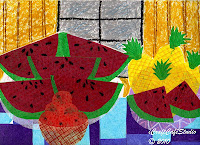WARNING : There will be small pieces (like buttons , pompoms ,etc ) Thoses pieces could cause a choking hazard ! So this craft is NOT suitable for children under 3 or any children who are still putting things in their mouth !!!
Motivation : Living in Southern California , we have no snow ...so turning to white socks to make a snowman is a great alternative ! Also with the cold weather and winter just around the corner , it is just the perfect art lesson for the season . With the holidays approaching , it will keep the children entertained and busy ....
Material :
* white sock (1 per student ) Tube socks are the best , but they may be hard to find . Adult crew socks will fine .
* white yarn
* uncooked rice for filling the socks
* pompoms ( 1 for the hat . Some smaller ones can be used for buttons , eyes and nose if you wish )
* Some orange clay or orange play dough ( to make a carrot for the nose )
* Some felt of various color for scarves , mouth , mittens , skis , etc ,
* 1 white chenille for arms (you can use a brown one if you want the arms to look like branches )
* sharpies to print details on scarves or/and hat
* any other small items from the craft store that you want to use for decoration such as fake berries , tiny pine cones , fake pine branches ,cinnamon sticks , etc .
* hot glue or super glue
Activity :
1. Give each student one white sock .
2. Have each student fill the bottom of their sock with 3/4 of a cup to 1 cup of rice depending of the size of the sock .
3. Once the rice is inside the sock ,toss it around a little to make a round shape . Then have the student tie a knot with white yarn .
4. Have the students add another 1/2 cup of rice to the sock to make the head . Shape it so it is round and tie a knot with white yarn at the top .
5. To create the hat , ask the student to turn over the reminder of the sock . They can have the choice to tie the top of their hat with another piece of white yarn , glue a pompom or cut the top to make fringes . Whatever they prefer .
6. They can now start decorating their snowman . To make a scarf , they should cut a long rectangle of felt and glue it to the neck area of the snowman .
7. They can glue buttons or small pompoms for the eyes and the buttons of the snowman .
8. They can also cut small circles of black felt with a whole puncher to make the mouth .
9. They should then take a small amount of orange clay or play dough and make a carrot for the nose . Glue it to the snowman's face .
10. They should shape the chenille around the snowman body and glue it . It will be the arms . They can also glue some small berries or flowers , or cinnamon sticks to the arms if they wish to .
11. With a Sharpie , the students can finally add the last details to their cute little snowman .
I hope you will enjoy this project as it is a fun one for the students !
Examples :





 © 2010
© 2010



